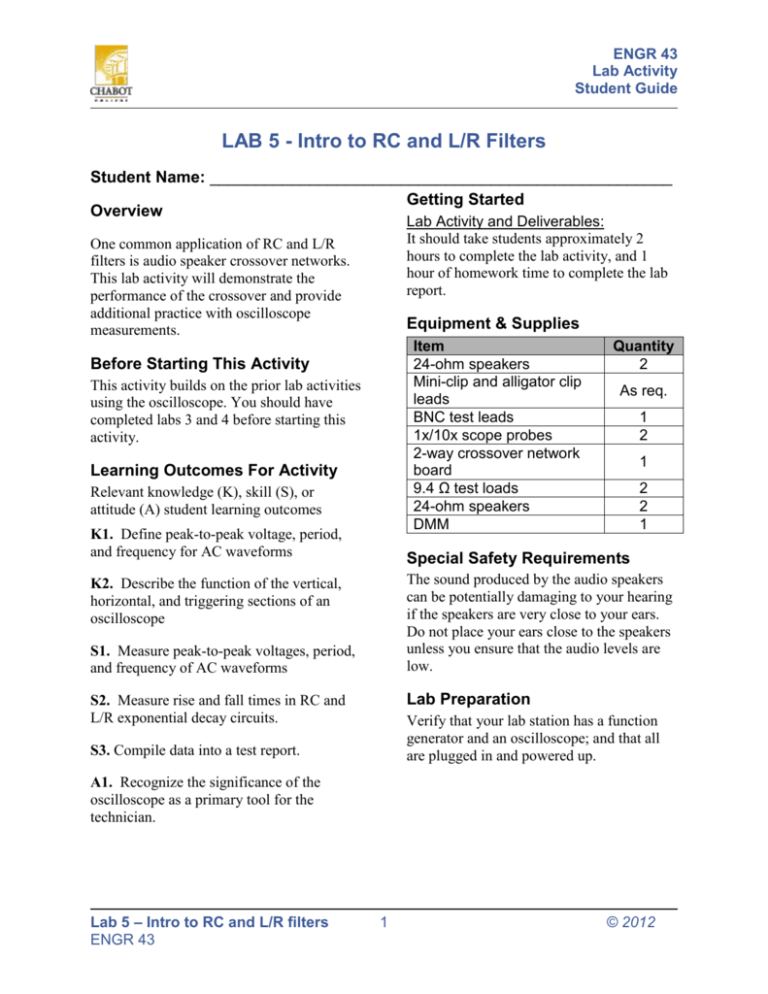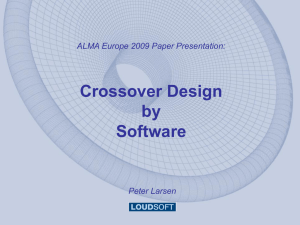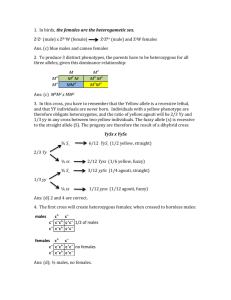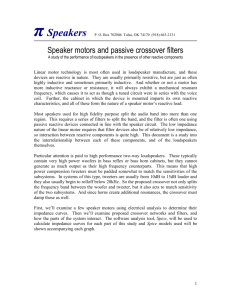ENGR43Lab5 - Chabot College
advertisement

ENGR 43 Lab Activity Student Guide LAB 5 - Intro to RC and L/R Filters Student Name: ___________________________________________________ Getting Started Overview Lab Activity and Deliverables: It should take students approximately 2 hours to complete the lab activity, and 1 hour of homework time to complete the lab report. One common application of RC and L/R filters is audio speaker crossover networks. This lab activity will demonstrate the performance of the crossover and provide additional practice with oscilloscope measurements. Equipment & Supplies Item 24-ohm speakers Mini-clip and alligator clip leads BNC test leads 1x/10x scope probes 2-way crossover network board 9.4 Ω test loads 24-ohm speakers DMM Before Starting This Activity This activity builds on the prior lab activities using the oscilloscope. You should have completed labs 3 and 4 before starting this activity. Learning Outcomes For Activity Relevant knowledge (K), skill (S), or attitude (A) student learning outcomes K1. Define peak-to-peak voltage, period, and frequency for AC waveforms Quantity 2 As req. 1 2 1 2 2 1 Special Safety Requirements The sound produced by the audio speakers can be potentially damaging to your hearing if the speakers are very close to your ears. Do not place your ears close to the speakers unless you ensure that the audio levels are low. K2. Describe the function of the vertical, horizontal, and triggering sections of an oscilloscope S1. Measure peak-to-peak voltages, period, and frequency of AC waveforms Lab Preparation S2. Measure rise and fall times in RC and L/R exponential decay circuits. Verify that your lab station has a function generator and an oscilloscope; and that all are plugged in and powered up. S3. Compile data into a test report. A1. Recognize the significance of the oscilloscope as a primary tool for the technician. Lab 5 – Intro to RC and L/R filters ENGR 43 1 © 2012 ENGR 43 Lab Activity Student Guide 2. Set the function generator for a sine wave output, and set the amplitude for a moderate output from the speakers. Use the rotary control to sweep the frequency from 100 Hz to 20 kHz. Listen to the output from the speakers. You should be able to hear the low frequency sine waves from the “woofer,” and as you increase the frequency, the output will shift to the “tweeter.” Introduction Audio crossover networks use the energystorage characteristics of capacitors and inductors to selectively block (attenuate) signals based on their frequency. When a capacitor is connected in series with a load, high-frequency signals can pass to the load because the capacitor can charge and discharge rapidly. When an inductor is connected in series with a load, the inductor opposes changes in current, and the faster the change in current, the greater the opposition. This allows low frequencies to pass while blocking the high frequencies. The transition point between passing and blocking frequencies is known as the crossover frequency. The values of resistance, capacitance, and inductance determine the crossover frequency. 3. Adjust the frequency until the sound is evenly split between the two speakers. It will be difficult to determine “by ear” exactly where the “crossover point” will be. Make your best determination. Crossover frequency = __________Hz 4. Switch the function generator to a 1 kHz square wave. You should hear a low tone (the “fundamental”) from the woofer, and a higher tone (the “harmonics’) from the tweeter. 5. Experiment with other wave forms (triangle, ramp). Have your lab partner select a wave form and try to identify it by listening to the sound it produces. Trade places and let your lab partner try. Task #1 – Listen to the effect of the crossover network Follow the steps below to attempt to determine the crossover frequencies by listening to the speaker outputs. 1. Place two speakers face down on the test bench with the metal connection lugs facing you. Find the “+” and “–” markings near the lugs. Connect the speakers and crossover network to the function generator as shown in figure 1. Figure 1 Lab 5 – Intro to RC and L/R filters ENGR 43 2 © 2012 ENGR 43 Lab Activity Student Guide Task #2 – Measure the frequency response on o-scope channel 1 and re-adjust the function generator output for 1 Vp-p as measured on the o-scope, if necessary. 1. Remove the connections from the speakers and substitute the two 9.4 Ω test load resistors in place of the speakers, as shown in figure 2. 6. Move the channel 2 scope probe to the tweeter output (“T” on the crossover board). Repeat all the frequency measurements and enter the data in table 1. 7. Examine the Bode plot (another name for a frequency response graph). Determine the crossover frequency, sometimes noted as fc. fc = ___________ Hz How does this compare with the crossover frequency in step 3 in Task #1? ________________________________ Figure 2 2. Connect the o-scope channel 1 probe to the function generator output (probe to red, ground to black). Connect channel 2 probe to the woofer output (“W” on the crossover board), and the probe ground to the circuit ground ________________________________ 3. Set the function generator: Amplitude (VhiZ setting): 1 Vp-p, Waveform: sinewave, Frequency: 100 Hz. Measure the amplitude of the function generator output on channel 1 of the o-scope. Adjust the amplitude of the function generator (to compensate for loading effect) until the o-scope measures 1Vpp. What output voltage is shown on the function generator display? _____________________________ 4. Measure the peak-to-peak voltage at the woofer output (channel 2). It should closely match the input voltage. Enter this value in Table 1 of the data summary spreadsheet. 5. Repeat the measurements for the frequencies listed in table 1. As you adjust the frequency, check the voltage Lab 5 – Intro to RC and L/R filters ENGR 43 3 © 2012 ENGR 43 Lab Activity Student Guide Part 3: Measure the step response charge / discharge times 1. Move the channel 2 scope probe back to the woofer output. Set the function generator for a 1 kHz square wave output. With the channel 2 volts/div set to 100 mV, adjust the function generator amplitude for a channel 2 height of 5 divisions, as shown in figure 3. Measure the time for the waveform to rise to 63% (one time constant) of the full height (approximately 3.1 divisions). Figure 4 Enter your measured fall time in Table 2 of the spreadsheet. 3. Enter the resistance of the load (9.4 ohms) in Table 2. The spreadsheet will calculate the values of the capacitor and inductor for the crossover. 4. Disconnect the crossover board from your test circuit. Use the capacitance measurement function on the DMM to measure the capacitance of the tweeter capacitor. Enter this value on your spreadsheet. Figure 3 Enter your measured rise time in Table 2 of the spreadsheet. 2. Move the channel 2 scope probe to the tweeter output. Adjust the function generator amplitude for a channel 2 height of 5 divisions, as shown in figure 4. Note that the negative-going half of the waveform will extend beyond the bottom of the display. Measure the time for the waveform to fall by 63% (one time constant) of the full height (approximately 3.1 divisions). Lab 5 – Intro to RC and L/R filters ENGR 43 Deliverable(s) Save your completed Lab 5 Activity Guide and Performance Report (which starts on the next page of this document) in your Lab Activity Binder. Print the spreadsheet and attach with your performance report. 4 © 2012 ENGR 43 Lab Activity Student Guide Lab 5 – Intro to RC and L/R Filters Student Name: ___________________________________________________ Note: Print and turn in the performance report pages along with the lab activity procedure pages. Scope Measurements Why is listening to the speaker outputs an inaccurate method for determining the crossover frequency? Why was it helpful to replace the speakers with load resistors for the measurements? The capacitor and inductor values on the crossover board were selected for use with 8Ω speakers (close to our 9.4Ω load resistors). However, our speakers are rated at 24Ω impedance. How does this effect the crossover frequency in Task #1, when you were trying to determine the crossover frequency by listening to the speakers? (Hint: crossover frequency is where R=1/2πfC and R=2πfL). Lab 5 – Intro to RC and L/R filters ENGR 43 5 © 2012 ENGR 43 Lab Activity Student Guide What difficulties did you have in measuring the decay time of the tweeter output in step 2 of Task #3? Can you describe this in terms of how the tweeter filter reacts to the harmonics of the input signal? Why doesn’t the woofer output present the same problem? Suppose you wanted the crossover frequency to be two times your measured frequency. If the speaker load resistance is unchanged, what values of capacitor and inductor would you use? (The rise and fall times would be one half of your measured values). Lab 5 – Intro to RC and L/R filters ENGR 43 6 © 2012








